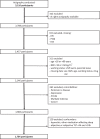Non-Right Handedness is Associated with More Time Awake After Sleep Onset and Higher Daytime Sleepiness Than Right Handedness: Objective (Actigraphic) and Subjective Data from a Large Community Sample
- PMID: 35547181
- PMCID: PMC9084907
- DOI: 10.2147/NSS.S358352
Non-Right Handedness is Associated with More Time Awake After Sleep Onset and Higher Daytime Sleepiness Than Right Handedness: Objective (Actigraphic) and Subjective Data from a Large Community Sample
Abstract
Purpose: Handedness has been linked to various physiological and pathological phenomena including memory function and psychiatric disorders. Also for sleep, several studies have reported associations. However, large-scale studies including a broad age span of participants and studies analyzing women and men separately are lacking.
Methods: Therefore, objective sleep data were determined using at-home actigraphy from 1764 healthy participants (18 to 80 years, 908 women), averaging five consecutive nights. In addition, subjective sleep-related data were captured by self-report diaries, the Pittsburgh Sleep Quality Index (PSQI), the Epworth Sleepiness Scale (ESS) and the Morningness-Eveningness-Questionnaire (MEQ). Handedness was determined with the Edinburgh Handedness Inventory (EHI) providing information on the direction (left vs right) and the degree of handedness (strong vs weak). To address the potential endocrine effects, premenopausal women (≤45 years) and postmenopausal women (≥55 years) were analyzed separately. This was also done for men.
Results: The degree and direction of handedness were correlated with "wake after sleep onset" (WASO) in the total sample and all women (the more right-handed/lateralized the shorter WASO). In postmenopausal women, additionally, time in bed (TIB) and total sleep time (TST) were correlated. There were no other significant associations between an objective sleep variable and handedness. In both premenopausal women and >55-year-old men subjective quality of sleep (PSQI) was correlated with direction and degree of handedness (the more right-handed/lateralized the better). In the total sample and postmenopausal women, the degree and direction of handedness were negatively correlated with daytime sleepiness. The chronotype was not associated with handedness in any group.
Conclusion: While associations were not consistent in all groups, overall, right-handedness tended to be associated with better sleep and less daytime sleepiness. Handedness and sleep seemed to be differentially associated in women and men, being in line with endocrine interactions.
Keywords: actigraphy; daytime sleepiness; handedness; menopause; sleep.
© 2022 Taubert et al.
Conflict of interest statement
All authors declare no conflicts of interest related to this work.
Figures
Similar articles
-
The Clinical Effect of Blue Light Therapy on Patients with Delayed Sleep-Wake Phase Disorder.Nat Sci Sleep. 2022 Jan 18;14:75-82. doi: 10.2147/NSS.S344616. eCollection 2022. Nat Sci Sleep. 2022. PMID: 35082544 Free PMC article.
-
Circadian preference and sleep-wake regularity: associations with self-report sleep parameters in daytime-working adults.Chronobiol Int. 2011 Nov;28(9):802-9. doi: 10.3109/07420528.2011.613137. Chronobiol Int. 2011. PMID: 22080786 Free PMC article.
-
Habitual sleep/wake patterns in the Old Order Amish: heritability and association with non-genetic factors.Sleep. 2011 May 1;34(5):661-9. doi: 10.1093/sleep/34.5.661. Sleep. 2011. PMID: 21532960 Free PMC article.
-
Subjective Assessment of Sleep Quality and Excessive Daytime Sleepiness in Conventional Hemodialysis Population: A Single-Center Experience.Int J Nephrol Renovasc Dis. 2022 Mar 14;15:103-114. doi: 10.2147/IJNRD.S351515. eCollection 2022. Int J Nephrol Renovasc Dis. 2022. PMID: 35309710 Free PMC article.
-
Differences Between Consistent and Inconsistent Handedness Remain Consistently Interesting: Ten Years of Research on the Consistency of Handedness With the Edinburgh Handedness Inventory.Percept Mot Skills. 2024 Feb;131(1):5-16. doi: 10.1177/00315125231217624. Epub 2023 Nov 23. Percept Mot Skills. 2024. PMID: 37994625 Review.
Cited by
-
Fifty Years of Handedness Research: A Neurological and Methodological Update.Brain Sci. 2024 Apr 24;14(5):418. doi: 10.3390/brainsci14050418. Brain Sci. 2024. PMID: 38790397 Free PMC article.
-
Hand dominance shift during sleep in sexsomnia: a clue to pathophysiology?J Clin Sleep Med. 2025 May 1;21(5):937-941. doi: 10.5664/jcsm.11554. J Clin Sleep Med. 2025. PMID: 39815730
References
-
- Christman SD, Propper RE. Dreaming, handedness, and sleep architecture: interhemispheric mechanisms. Int Rev Neurobiol. 2010;92:215–232. - PubMed
LinkOut - more resources
Full Text Sources



